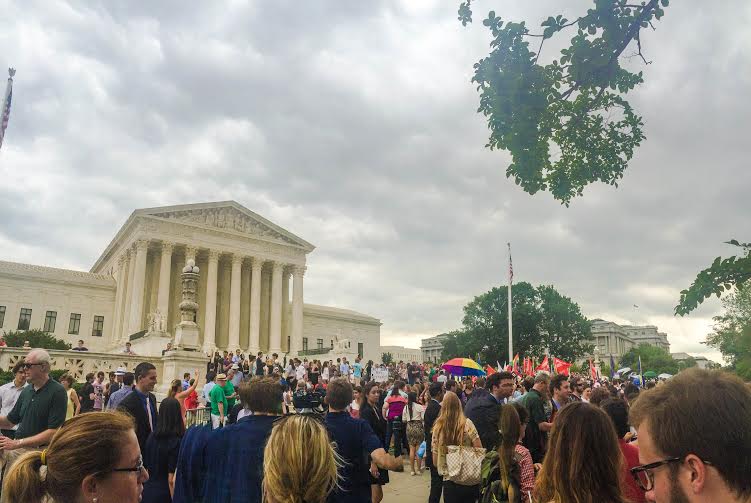Supreme Court speaks, Ohio responds
By: Amanda Dee – Online Editor-in-Chief
Images courtesy of UD students in Washington, D.C.*
[gss=”medium” ids=”1204513,1204507,1204511,1204506,1204512,1204508,1204515,1204509,1204510,1204516,1204514″]
The Ohio State Bar Association webcasted a panel discussion Tuesday on what the Supreme Court’s same-sex marriage ruling in Obergefell v. Hodges legally means for Ohioans.
“It means that within hours people were getting marriage licenses, thanks to Judge [Jan] Long [panelist from the Pickaway County Probate/Juvenile Court]… People who had been together for 30 years were getting married,” said Jennifer L. Branch, counsel who began the journey with Obergefell plaintiffs in Cincinnati.
In the webcast, “The Supreme Court Speaks: The Next Steps for Marriage Equality,” the panel addressed the basis of the Supreme Court’s decision before getting into legal questions and stipulations in front of a live audience–a member of which was Staci Rucker, the University of Dayton Law School assistant dean of student affairs.
What the decision boiled down to was the Due Process Clause of the 14th amendment, which guarantees U.S. citizens the rights to life, liberty and property. And that means, as of June 26, same-sex couples have equal dignity “in the eyes of the law,” Branch explained. It means the government cannot allow discrimination on the basis of sex to prohibit a marriage because marriage is a Constitutional right for all U.S. citizens.
Religion was immediately and explicitly addressed by Justice Anthony Kennedy: “It must be emphasized that religions, and those who adhere to religious doctrines, may continue to advocate with utmost, sincere conviction that, by divine precepts, same-sex marriage should not be condoned.” As Branch put it, “There’s no law in Ohio that says the officiant must, that the rabbi must, perform that wedding.”
The panel agreed best practice options, letting staff choose whether or not to take these cases, could avoid lawsuits and unrest on both ends.
But in a state with a Constitutional amendment that has prohibited same-sex marriage (The Ohio Definition of Marriage Amendment) for a decade, what happens next?
First on the legislature’s agenda, Branch said, the language of the 2004 marriage amendment defining marriage in the state as “between one man and one woman” must be altered.
Immediately after the ruling on June 26, The Ohio Supreme Court did, however, issue an order to all state courts. The order states that until the literature in rules and forms are formally amended, court references to familial relationships, like “father” and “mother,” are to be “construed as gender neutral where appropriate,” according to Court News Ohio.
Across the board, it now must be determined how to figure out a couple’s legal date of marriage: whether it’s the Supreme Court, respective state or personal commitment ceremony date. The issues that are bundled up with marriage, specifically for same-sex marriages now need to be addressed: adoption, surrogacy, pensions, discrimination.
“Couples in Ohio today can get married and go to work and show pictures on their phone of their wedding, and their boss can come up and say, ‘Hey, you’re fired,’” Branch cautioned.
Though there are difficulties to face, “it’s business as usual” for most of the courts, said Hon. Dana S. Preisse of the Franklin County Domestic Relations Court. She said she doesn’t see any difference in terms of shared parenting for same-sex couples.
Questions about common law marriages were quickly dismissed by Hon. David A. Hejmanowski of the Delaware County Probate/Juvenile Court because common law marriages are banned in Ohio. And most legal forms, he said, are already gender-neutral, including adoption and election forms, which say “spouse.”
But, “with marriage unfortunately comes, for some, divorce,” Hon. Preisse said.
One of the first inquiries Hon. Preisse was presented with was a same-sex couple legally married in another state that had a child from insemination by an unknown donor. Things are messier in cases of child support and custody because in Ohio, according to Hon. Preisse, the current law states that the husband of the mother is presumed to be the father of the child. So what does the court do when the case is between two women?
Branch suggested another change of language to resolve this, replacing the “paternity” affidavit, which legally binds a “father” and “mother” to a child, to an “acknowledgement of parentage” affidavit, which could legally bind a “parent” to a child.
OSBA moderator William K. Weisenberg then shifted the question to agency: “Is this going to require the General Assembly to look at these statutes and clarify them as a matter of public policy?”
Hon. Hejmanowski answered that this is a “quandary” but organizations like OSBA could bridge the gap between the “bench and bar.” Law and procedure committees can work on changes in the interim, Hon. Long suggested.
Despite the actions of both branches, opposition still exists in the assembly and at the federal level. Gov. John Kasich still declared himself an opponent of same-sex marriage in a budget session after the ruling (though, he is less outspoken than some other Republicans). There were still four votes against the plaintiffs, including that of Chief Justice John Roberts, who argued in his dissenting opinion that this issue should have been addressed outside of the courtroom by the people. But Branch disagreed.
“When you’re a minority and there’s been a history of injustice against you, the court needs to look at this, not the legislature,” she said. “We can’t wait for people to vote and make that change. The freedoms change with every generation.”
If you have questions on the same-sex marriage ruling and its legal effects, please email webquestions@ohiobar.org.
Photos courtesy of Emily Keane, Dom Sanfilippo, EK, DS, EK, DS, Ian Edgley, DS, DS, Melissa Siegel and EK, respectively.
*Staci Rucker could not be reached for comment.

